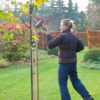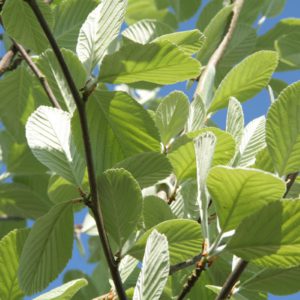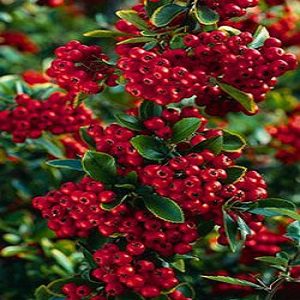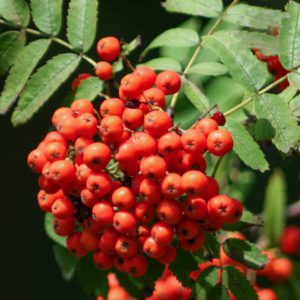Prunus Snow Goose
€500.00
Frequently Bought Together


Description
Quick Facts
- Common Name: Snow Goose Flowering Cherry, Snow Goose Ornamental Cherry
- Botanical Name: Prunus ‘Snow Goose’
- Plant Type: Deciduous ornamental tree
- Mature Height: 6-8m
- Mature Spread: 4-6m
- Flowering Period: April
- Flower Colour: Pure white, semi-double to double flowers
- Foliage: Fresh green leaves turning orange-red in autumn
- Hardiness: RHS H6 (fully hardy throughout UK and Ireland)
- Soil Requirements: Moist, well-drained, fertile soil; tolerates most soil types
- Aspect: Full sun to partial shade
- Maintenance: Low
Description
Experience the breathtaking beauty of Prunus ‘Snow Goose’, one of the most spectacular white-flowered ornamental cherries for gardens, where gracefully weeping branches become completely smothered in masses of pure white semi-double blossoms each spring creating cascading waterfalls of snowy flowers that transform gardens into enchanted wonderlands and herald the arrival of spring with unforgettable drama. This exceptional cultivar offers remarkable qualities—profuse masses of pure white semi-double to double flowers measuring 3-4cm across covering every gracefully arching and weeping branch in April creating breathtaking cascading displays that resemble snow-laden branches or flocks of white geese in flight (hence the evocative name), elegant weeping habit with arching branches that sweep gracefully towards the ground creating romantic sculptural silhouette and year-round architectural presence, fresh bright green foliage emerging after flowers providing lush summer canopy that turns beautiful shades of orange, amber, and red in autumn extending seasonal interest, and exceptional hardiness thriving reliably throughout temperate climates with vigorous growth and reliable spectacular flowering year after year, making this one of the most rewarding and dramatic choices for adding spring spectacle, graceful weeping form, and multi-season interest to gardens, lawns, avenue plantings, and anywhere a truly unforgettable flowering tree is desired to create magical spring moments and romantic garden atmosphere.
Throughout the seasons, this captivating tree displays its most spectacular features in spring—the gracefully arching and weeping branches become completely smothered in masses of pure white semi-double to double flowers that open from pale pink buds, each blossom measuring 3-4cm across with delicate petals arranged in generous clusters that cover the branches so profusely the foliage is barely visible creating solid cascades of white. The flowers emerge before or with the young leaves in April, creating maximum visual impact when the branches appear to be draped in pure white lace or covered in fresh fallen snow. The semi-double to double form gives each flower extra substance and presence compared to single-flowered varieties, and the pure white colour creates luminous displays that glow in spring sunshine and moonlight. The weeping habit is the defining characteristic—branches arch gracefully outward and downward creating elegant fountains of blossom that sweep towards the ground in romantic cascades, the weight of the flowers enhancing the weeping effect during peak bloom. The overall effect during flowering is absolutely breathtaking—like standing beneath a waterfall of white petals or watching flocks of white geese taking flight. Following the spectacular floral display, fresh bright green leaves emerge creating lush summer canopy with serrated ovate leaves that provide dappled shade and rustling movement. In autumn, the foliage transforms to beautiful warm tones of orange, amber, and red creating second season of colour before leaves fall to reveal elegant branch structure. The gracefully weeping architectural form provides year-round sculptural presence and romantic silhouette even in winter when bare branches create elegant tracery against the sky.
Prunus ‘Snow Goose’ is a relatively recent introduction bred specifically for its exceptional combination of pure white semi-double flowers, profuse flowering, and graceful weeping habit—the name perfectly captures the image of masses of white flowers resembling flocks of snow geese or snow-covered branches. This cultivar represents the pinnacle of ornamental cherry breeding, combining the most desirable characteristics of weeping form, white flowers, and reliable performance. Hardy to RHS H6, this robust tree thrives throughout UK and Ireland with complete reliability, tolerating cold winters, late frosts, and variable weather without damage to flower buds or growth. Vigorous growth rate once established, adding 30-50cm annually, reaching impressive mature size within 10-15 years. The weeping habit develops naturally without training, though can be enhanced by removing lower branches to create clear trunk that showcases the cascading branches. Particularly valuable for its exceptional flowering performance—flowers reliably and profusely every spring regardless of weather, creating dependable spectacular displays. Also offers excellent disease resistance compared to some older cherry cultivars, with good resistance to bacterial canker and silver leaf. The combination of spring flower spectacle, graceful weeping form, autumn colour, and year-round architectural presence makes this outstanding for specimen planting, focal points, lawn trees, and anywhere a truly memorable flowering tree is desired.
Create stunning compositions by planting as magnificent specimen tree on lawns where its graceful weeping form and cascading spring blossoms can be viewed from all angles and appreciated as focal point, positioning near seating areas, patios, or viewed from windows where the spectacular spring display and romantic weeping habit can be enjoyed up close and the flowers appreciated at eye level, or using in avenue plantings or repeated along driveways where multiple trees create breathtaking tunnels of white blossom in spring and elegant rhythm throughout the year. Exceptional in spring gardens combined with spring bulbs planted beneath (daffodils, bluebells, tulips) that bloom simultaneously creating layered displays of white and complementary colours, Japanese-inspired gardens where the graceful weeping form and spring blossom create authentic character paired with acers, azaleas, and ornamental grasses, or romantic cottage gardens where the cascading flowers and autumn colour fit perfectly with traditional planting schemes. Works beautifully planted as single specimen where each tree develops full weeping form and creates maximum impact, near water features or ponds where the weeping branches can reflect in water creating doubled beauty, or combined with evergreen backdrop (yew hedging, holly, photinia) that emphasizes the pure white flowers and provides year-round context for the deciduous tree. Also magnificent underplanted with shade-tolerant perennials (hostas, ferns, hellebores, epimediums) that thrive beneath the summer canopy and create layered planting, or surrounded by spring-flowering shrubs (forsythia, ribes, spiraea) that bloom simultaneously creating abundant spring garden. Perfect for adding spring spectacle, graceful weeping form, and multi-season interest to gardens, lawns, avenue plantings, and anywhere a truly unforgettable flowering tree is desired to create magical spring moments and romantic garden atmosphere throughout the year.
Caragh Garden Notebook
Planting: Space trees 6-8m apart for individual specimens allowing room for mature spread and weeping branches, or 5-6m apart for avenue plantings where canopies will eventually touch creating continuous effect. Plant bare-root specimens November-March during dormancy (ideal for best establishment and value), or container-grown specimens year-round though autumn or early spring is preferred. Choose position in full sun for best flowering—tolerates partial shade but flowering may be reduced. Requires open position with room for weeping branches to develop and sweep towards ground without obstruction. Dig generous planting hole at least twice width of root ball and same depth—avoid planting too deeply which can cause poor establishment and disease. For bare-root trees, create mound of soil in centre of hole and spread roots over mound ensuring no roots are bent or circling. For container-grown trees, gently tease out circling roots. Incorporate organic matter (well-rotted compost, leaf mould) into backfill soil. Plant at same depth as nursery soil mark on trunk—avoid burying trunk which causes rot. Backfill carefully, firming soil gently to eliminate air pockets. Water thoroughly after planting. Apply 5-8cm mulch of organic matter around base in 1m diameter circle, keeping mulch clear of trunk (10cm gap) to prevent rot. Stake securely using single vertical stake or angled stake for bare-root trees, or double stakes with crossbar for larger container-grown specimens—use tree ties with spacers to prevent rubbing. Stakes should support tree for first 2-3 years until established. Water regularly during first two growing seasons to establish deep root system. Position where the spectacular spring display and graceful weeping form can be appreciated as focal point.
Soil Preparation: Tolerates wide range of soil types including clay, loam, and sandy soils, but performs best in moist, well-drained, fertile soil. Prefers neutral to slightly alkaline pH (6.5-7.5) but adapts to most garden soils including slightly acidic conditions. Avoid waterlogged or very dry soils—consistent moisture during growing season promotes best growth and flowering. Improve heavy clay soils by incorporating organic matter and grit to improve drainage and structure. Improve light sandy soils by adding generous amounts of compost or well-rotted manure to improve moisture retention and fertility. Avoid very exposed positions with strong winds which can damage flowers and young growth. Mulch annually in spring with 5-8cm layer of organic matter (compost, well-rotted manure, leaf mould) in 1m diameter circle around base to conserve moisture, suppress weeds, improve soil fertility, and protect roots. Keep mulch clear of trunk. Best growth and flowering occur in full sun with moist, well-drained, fertile soil and shelter from strong winds.
Container Growing: Not suitable for long-term container growing due to vigorous growth and large mature size—this is a substantial tree requiring in-ground planting for proper development. Young specimens can be grown in very large containers (minimum 80-100cm diameter) for 2-3 years before requiring permanent planting, useful for patios or to delay planting, but will not thrive or flower well if kept in containers long-term. If growing temporarily in containers, use soil-based compost (John Innes No. 3), water regularly, feed in spring, and plan to plant in ground within 2-3 years for best results.
Seasonal Care: Requires minimal pruning—the naturally graceful weeping form develops without intervention. Prune only to remove dead, diseased, damaged, or crossing branches, carrying out any necessary pruning immediately after flowering (May-June) to avoid removing next year’s flower buds which form on current season’s growth. CRITICAL: Avoid pruning during autumn and winter when risk of silver leaf disease and bacterial canker infection is highest—cherries should only be pruned during active growth (May-August) when sap is flowing and wounds heal quickly. Remove any suckers arising from rootstock below graft union as soon as they appear. Can remove lower branches gradually over several years to create clear trunk (1.5-2m) that showcases weeping branches, but avoid removing too much in one year. Apply general-purpose balanced fertiliser or blood, fish and bone in spring around base to promote healthy growth and flowering. Mulch annually in spring. Water regularly during dry spells, particularly during first 3-5 years of establishment and during flowering and fruit development—established trees tolerate brief drought but consistent moisture promotes best growth. Watch for aphids on new growth (spray with water or encourage natural predators), caterpillars on foliage (remove by hand or use biological control), and signs of bacterial canker (sunken patches on bark, oozing gum—prune out affected branches during summer). Generally disease-resistant with good resistance to silver leaf and bacterial canker compared to older cultivars. Remove any fallen diseased leaves to reduce disease spread. The spring flowering is reliably spectacular and profuse!
Propagation: Cannot be propagated by home gardeners—this cultivar is grafted onto rootstock (typically Prunus avium) by specialist nurseries to maintain the weeping habit and flowering characteristics. Seed-grown plants will not come true and will not have the weeping form or flowering quality. Nursery-grown grafted specimens are essential for guaranteed weeping form and spectacular flowering.
This spectacular beauty is absolutely breathtaking—one of the most dramatic white-flowered weeping cherries available! Those masses of pure white semi-double to double flowers measuring 3-4cm across completely smothering every gracefully arching branch in April are absolutely stunning—creating cascading waterfalls of snowy blossoms that resemble flocks of white geese in flight! Graceful weeping habit with branches sweeping towards ground creating romantic sculptural silhouette, profuse reliable flowering year after year, fresh green foliage turning beautiful orange-red in autumn for extended seasonal interest. Vigorous growth reaching 6-8m tall with 4-6m spread. Fully hardy (RHS H6) throughout UK and Ireland—completely reliable in all conditions! CRITICAL: prune only immediately after flowering (May-June), never in autumn or winter when disease risk is highest. Perfect for specimen planting on lawns, near seating areas, avenue plantings, spring gardens, and anywhere you want truly unforgettable spring spectacle with graceful weeping form and romantic garden atmosphere. Pure spring magnificence and breathtaking elegance!





